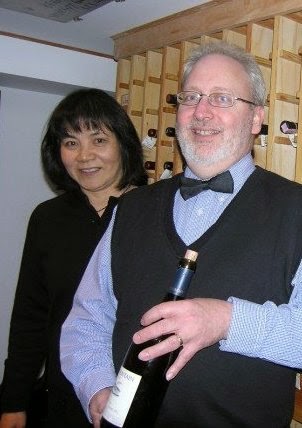Vintage. The word has a mystique, even
a magic - good vintage, bad vintage. Vintage cars, vintage fashion.
In many consumers' minds a vintage wine is a 'better' wine (whatever
'better' means). In some wine stores the vintage section is the good
stuff.
To us wine-geeks, vintage is so part of
our world and our language we don't think about how it can be
confusing. We automatically just think, ah 2003, very hot in France.
Wines are possibly forward, possibly stewed. Ah 2006 - great year in
Spain.
Vintage means weather during the season that the grapes were growing. Not the year the wine was made or the year
the wine was bottled. That's all - the weather. Why is weather
important? It is important because the weather is different every
year. A fine wine will reflect the difference. Not necessarily good
or bad, but different. That is one of the pleasures of wine - it
varies from year to year. You want same, you want absolute
consistency? Drink Coors lite. Drink Pepsi.
How does the weather affect the wine?
Can we tell the difference in our glass?
Yes. Here are a couple of simple
examples to help you understand. Let's say it is late in the growing
season. It is fall after a hot summer. The grapes are getting ripe
and ready to be picked. The grapes are filled with flavours and
sugars and acids. The skin of the grape is getting soft and pliable.
Let's say there is a heavy rain just before harvest. The vine says to
itself, "hurray, I am so thirsty." And it sucks as much of
the rain into its roots as it can and sends the needed moisture up to
the grapes. The grapes plump up with water.
The farmer says to himself, "darn,
now I have to pick these grapes in the mud."
And when the grapes are made into wine,
the wine now is more dilute, less intense. More of the wine is water,
less is flavour. And the winemaker says to himself, "That year,
that vintage, you can taste the rain in the wine." And he is
quite literally correct.
Let's take another example. Let's say
the growing season has been exceptionally warm. The grapes ripen very
quickly. The grapes get very ripe and filled with so-sweet juice. If
you go to the vineyard before the harvest and taste the grapes they
are very sweet, perhaps ten times sweeter then table grapes you buy
at Safeway. When the grapes are made into wine, the yeast is very
happy. The yeast has lots of sugar to eat and to convert to alcohol.
When the yeast is done, the wine has more alcohol than normal. More
sugar means more alcohol. Later when you and I enjoy that wine, we
feel the warmth of the
alcohol in our chest as we swallow.
The winemaker say, "That year,
that vintage you could feel the warmth of the sun in the wine."
And he is quite literally correct.
So you can understand through these
simple examples how weather affects what is in our glass. Now, what
about this whole good year, bad year, business? How difficult is this
wine drinking anyway? Does every wine drinker have to remember what
are the good years for every wine growing region on earth?
No we don't. We can break out of the
good-bad paradigm and remember that vintage just means different. One
of the characteristics of fine wine is the vintage variation. There
is very good news on the good year/ bad year front. And as a smart
consumer you can use the good year/bad year mystique to your
advantage.
The good news it thanks to climate
change and advances in vineyard and winemaking technology, there
really are no truly bad years anymore. We only have good years and
better years. Remember vintage just means different, not good or bad.
Now, a lot of people in the wine
industry and the wine press spend a lot of time declaring this
vintage is good or bad and rating vintages and so affecting the
price of wines. Here is how to use this to your advantage. If the
wine press declares that such and such a year was a good year in such
and such a region, two things will be true - first the prices of all
wines from that region will tend to go up. Second, the quality of all
the wines also tend to go up. As the saying goes, a high tide lifts
all boats.
Now, if the press declares that the
vintage was poor, two other things tend to be true - first the prices
of all wines from that region tend to not go up. But the great
producers will still make great wine. The wine from the top producers
should be different then usual, but the great producers, with skill
and experience, will still make wonderful wines.
How to use this to your advantage? In
the good years buy the lower producer. In the bad years buy the great
producers. You will save lots of money and still drink fantastic
wines.
Let's get away from the whole good/bad
mystique of the vintage. Let's enjoy the nuance and differences that
different years offer.
©
2014 Wine Wisdom
